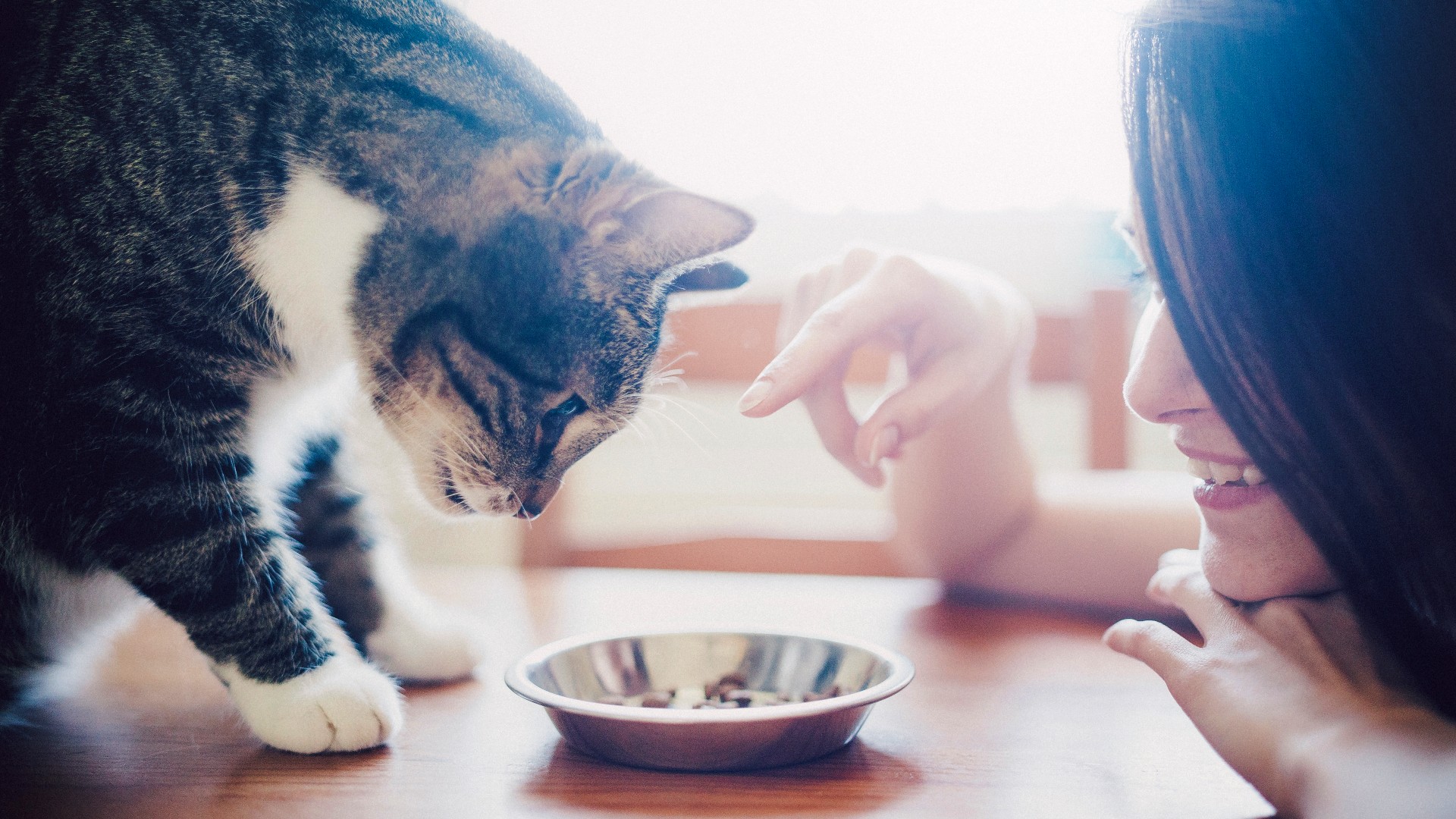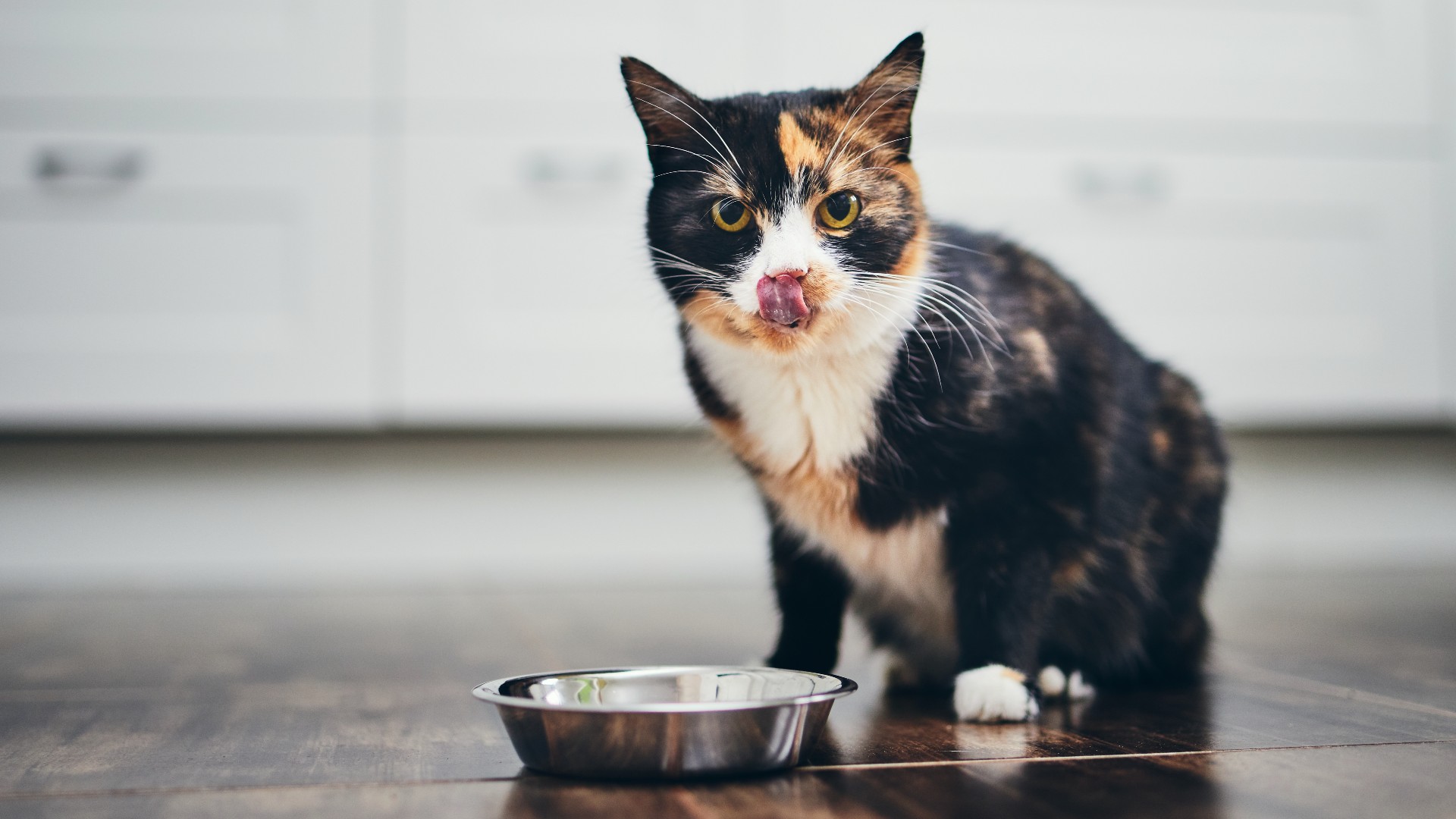Why does my cat want me to watch her eat?
Pondering the question 'why does my cat want me to watch her eat?' We breakdown the answer and give you tips to help your kitty get comfortable dining alone

If the question ‘why does my cat want me to watch her eat?’ is playing on your mind right now, rest assured, you’re not alone! While cats can be super independent little creatures, believe it or not, having you around while they eat can be incredibly comforting for them.
Have you ever had times when your cat is meowing around your feet indicating they want something to eat but when you go to check their food bowl, it’s already filled to the brim with the best cat food? If so, that’s a really great sign that you have a social kitty on your hands who likes company while they eat.
But being highly social isn’t the only reason that your feline friend may want you to watch them eat. Below, we explore some of the things that drive this behavior and provide you with some handy tips and tricks for what to do if your kitty refuses to eat alone.
- Is homemade cat food better than store bought? A vet answers
- Changing cat food: How to transition cat food safely
- How long can cats go without food? When to be concerned if your cat stops eating
Why does my cat want me to watch her eat?
While it may sometimes feel like your feline friend is being a bit of a diva, there are actually a range of legitimate reasons why they might feel more comfortable having you with them while you eat. Let’s take a look at a few of the most common:
1. Your cat is a social eater
While wild cats are highly territorial when it comes to their food, the same isn’t true for all domestic cats, who often grow to be incredibly social due to all the petting they receive.
Just as many humans like to sit down around a table and enjoy a meal together, some cats also prefer that kind of social eating as opposed to dining alone. Despite popular misconceptions, cats can become very attached to their owners and they may view mealtimes as an opportunity to spend time with you and bond.
2. Trust and safety
One of the most vulnerable moments in the day for wild cats is feeding time as they have to remain on high alert to ensure another animal doesn’t try and come along and steal their catch. While your little feline friend isn’t in the same situation, this desire to feel safe while they’re eating is deeply embedded into their DNA. This need to protect their food can be especially prevalent if you have other animals in the home.
Another reason your cat may feel vulnerable if they’re eating alone is the position of their food bowl. Most of us tend to place our cat’s food bowl up against a wall or in a corner, which means our kitty needs to turn their back to the rest of the world while they eat and become largely unaware of their surroundings while they’re chowing down.
Having you there while they eat can actually help your cat feel safe and protected, helping them to relax and enjoy their meal without all the added stress of having to remain on high alert in case another animal comes along and tries to steal their food.
3. They don’t want to miss out on anything
Some cats are very social and love being the center of attention, so the fact that they might miss out on something while they’re away at their food bowl is enough to make them seriously consider skipping a meal!
You’ll know that this is the reason for them wanting you around while they eat if you notice them being unable to concentrate on their food, lifting their head up frequently to scan the room or continually popping back and forth between you and their food bowl.
If you tend to eat at the same time as your cat and you notice that when you stop eating and get up to do something that they follow, this is a really good sign that you have a social butterfly on your hands who doesn’t want to miss out on what’s going on.
4. Illness
While your cat wanting you around when they’re eating isn’t usually a cause for concern, it’s worth taking note if you find your kitty won’t eat at all unless you’re there with them. Often when we’re sick, it’s comforting to have someone with us, and the same is true for our feline friends.
A loss of appetite or other symptoms, such as vomiting, are two key signs that your kitty may be feeling unwell. If they’ll take a little bit of food from the palm of your hand but won’t eat otherwise, be sure to consult your vet who will be able to get to the bottom of what’s going on.
5. Habit
It could also be that your cat has simply developed a habit for having you around at mealtimes based on how they were raised. If your cat was syringe fed while they were a kitten or held a lot when they ate, they’ll likely associate food with your presence.
Why cats want you to walk them to their food

If watching your kitty eat wasn’t enough of an ask, some cats will expect you to escort them to their food bowl as well! This is usually their way of telling you that they want you to come and hang out with them while they devour their meal, but there may be a few other reasons for this behavior.
You’ll find it particularly common if you feed your feline friend the best wet cat food as it tends to go off a lot quicker than kibble, so getting you to follow them to their food bowl may be their way of alerting you to the fact that their food isn’t as fresh as they’d like it to be.
Another reason is that some cats enjoy being stroked while they’re eating as this puts them in a very calm and relaxed state that enables them to slow down and enjoy their meal. Remember, cat’s are wired to be on high alert when they eat, so being stroked or spoken to in a soothing tone can be incredibly comforting for them.
What should I do if my cat refuses to eat alone?
While in some ways it’s super sweet that your kitty refuses to eat without you there, it could lead to health issues long term as you’re not always going to be able to join them at mealtimes and the last thing you want is them losing weight.
The good news is, there are ways that you can help your cat get more comfortable dining alone:
1. Move their food bowl
There’s no point investing in the best cat food bowl if your feline friend refuses to eat out of it! If you notice that you have a very social cat on your hands, it might be worth relocating their food bowl to a high traffic area where they’ll be able to feel part of the action and enjoy their meal at the same time.
2. Gradually reduce your presence
Another thing you can try is only joining your kitty for part of their meal, slowly reducing the amount of time you spend with them until they’re comfortable eating on their own.
Try putting down your cat’s food bowl and then standing there like you normally would as they start eating but walk away before they finish. If you find they protest loudly (and some cats will) rejoin your cat and then repeat the exercise over several days until the protest behaviors stop.
3. Increase the amount of bonding away from mealtimes
You may find that your cat is more than happy to eat alone as long as they’re getting enough time with you throughout the day. Try investing in a few of the best cat toys and spending around 15-20 minutes twice a day playing with your feline friend.
Adding one of the best cat brushes to your grooming kit and engaging in regular brushing sessions can also be a really lovely way for the two of you to bond. You can also try regularly petting your kitty whenever you walk past them, and if you have a lap cat, invite them up for a cuddle while you’re reading or watching TV.
Read next: How much should I feed my cat?
PetsRadar Newsletter
Get the best advice, tips and top tech for your beloved Pets

Kathryn is a freelance writer who has been a member of the PetsRadar family since it launched in 2020. Highly experienced in her field, she's driven by a desire to provide pet parents with accurate, timely, and informative content that enables them to provide their fur friends with everything they need to thrive. Kathryn works closely with vets and trainers to ensure all articles offer the most up-to-date information across a range of pet-related fields, from insights into health and behavior issues to tips on products and training. When she’s not busy crafting the perfect sentence for her features, buying guides and news pieces, she can be found hanging out with her family (which includes one super sassy cat), drinking copious amounts of Jasmine tea and reading all the books.
